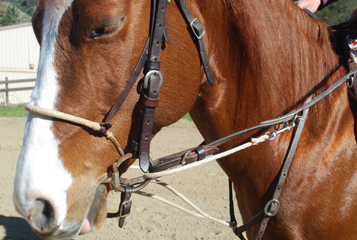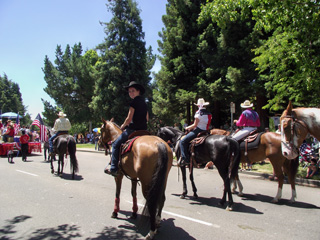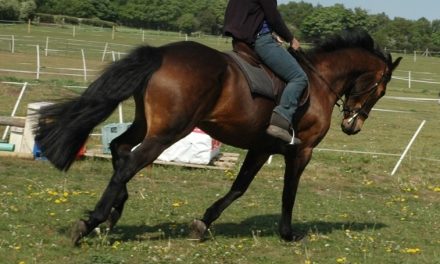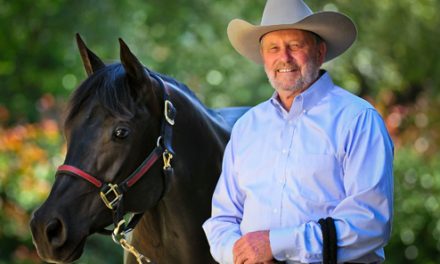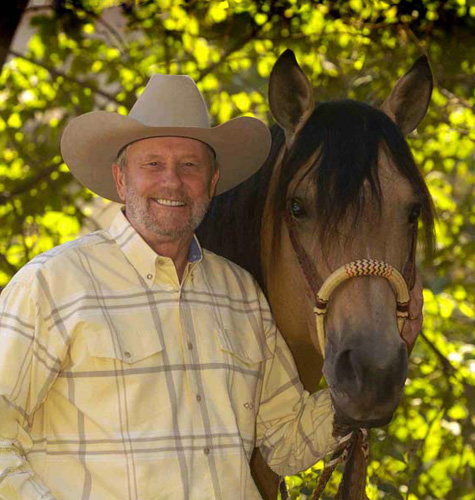
Over the last 35 years I have worked with many blind horses, probably three or four dozen. Most have been blind in one eye, and some totally blind. Through practical experience I’ve found that when a situation like this happens, the horse wakes up one morning and can’t see and life goes on. Unlike the human reaction where we, with our mental processes and rational minds, understandably fall apart until we come to terms with it. We must become familiar with what we have and with our space. We must learn to accept and cope with life. With a horse, blindness comes much easier. They don’t have the trauma of the loss of something and they don’t have the emotional stress. I think with horses that are blind in both eyes, they learn to rely on other senses just like humans, hearing and smell and a level of acuity. Like humans, they utilize their other senses to adapt to the best of their ability. Obviously, it is easier for a horse that is blind in only one eye but I have worked with horses that were blind in both eyes. I could take them out on the trail, do arena work and do probably 99% of the normal activities. The only difficulty would be with jumping and cutting because a horse has to be able to see to judge distance. Once you put a horse on a cow, the horse must start tracking that cow. Those would be the only activities limited by blindness.
With a horse that is blind in one eye or both eyes, it is really important to establish a foundation. With a foundation you establish consistent cues and the horse starts trusting those cues. Some time ago I was working with two horses at the barn that were both blind in one eye. One used to be a cutter. We started using him as a reining cow horse and we could take him down the fence. We needed to show him when to cut into the fence but that was the only help he needed. Both horses were fine on the trail and doing arena work. One was actually calmer and more relaxed on the trail on his blind side. With his sighted eye he sometimes saw things that he wanted to react to.
I treat both sighted and blind horses the same. I sack them both out with objects and train them both to do round pen work with inside and outside turns. The thing to remember is that when you approach a horse that is blind in one or both eyes, it is important to let the horse know that you are approaching. Eventually, they gain a perceptual sense of where you are. For example, we use a golf cart to pony our horses from one end of the ranch to the other. The blind horses that we had needed to learn to gage their distance from the cart on their blind sides. We helped them learn this by teaching them to move off pressure with groundwork first. When, at first, they got too close to the cart, I just reached out with my arm and bumped them away. I also used a dressage stick, which gave me more length to tap them on the shoulder to move them away and show them where they needed to be. After awhile, we no longer needed to do this. They learned to gage the distance from objects through sound and feel.
When working with a blind horse, most people want to placate and protect it. In other words, they want to help the horse by limiting him. We are not helping the horse by making him feel handicapped. I don’t treat a blind horse differently than a sighted horse. I treat them just like a sighted horse when I am doing groundwork. I start teaching concentrated circles and teaching them to back up on both sides. The only difference is that when I step over to the other side, I cluck and let the horse know. The horses I had at the barn quickly learned to feel and sense my presence and I no longer needed to cluck.
A horse that is blind can still be very functional. We taught one of our horses to do ranch versatility since he had only one eye. A horse that is blind in both eyes can certainly do arena work and go on the trail. A totally blind horse can be turned out to pasture and can certainly be turned out alone in a corral. You have to let the horse know where the boundaries are. The horse can also be turned out with other horses and can benefit from a buddy but you have to make sure the other horse is not aggressive. You need to watch them closely at first to make sure they get along as a blind horse is easily bullied and can get hurt easier than a sighted horse.
The only things that may hinder the learning of a blind horse or determine how quickly he learns, are the horse’s personality, his emotional level and your consistency. If you have a willing horse, a horse that likes to learn and moves off pressure easily, he’s going to learn quicker. If you have a horse with a high emotional level, it will take a little longer for him to understand the lesson. How quickly the horse learns and how successful you are will depend on your consistency. Consistency means doing things in the same way every time. Treat the horse like a sighted horse but just be aware that he can’t see.

